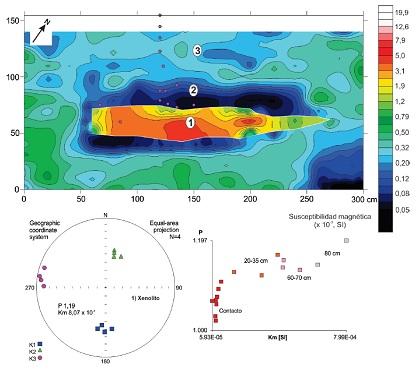S. Geuna, L. Escosteguy, B. Díaz Appella, F. D´Eramo y L. Pinotti
2 016
Latinmag Letters, Volume 6, Special Issue (2016), D11, 1-7. Proceedings São Paulo, Brasil
Se estudiaron dos xenolitos de un gneis tonalítico-biotítico contenidos en la trondhjemita El Hongo
(Cámbrico), que tienen susceptibilidad magnética significativamente mayor que la de la roca encajante,
debido a la presencia de magnetita. En uno de los xenolitos la magnetita es acompañada por ilmenohematita, y en el otro, por hemoilmenita y pirita. La misma asociación se observa en el plutón circundante, en uno y otro caso, aunque la magnetita aparece martitizada, mientras el óxido romboédrico permanece fresco. Alrededor de uno de los xenolitos se observa un halo desmagnetizado que se interpreta como debido a una reacción destructiva de magnetita, para formar titanita. Se discute la importancia de la roca de caja como control de la asociación de óxidos en distintas áreas del cuerpo ígneo.
(Cámbrico), que tienen susceptibilidad magnética significativamente mayor que la de la roca encajante,
debido a la presencia de magnetita. En uno de los xenolitos la magnetita es acompañada por ilmenohematita, y en el otro, por hemoilmenita y pirita. La misma asociación se observa en el plutón circundante, en uno y otro caso, aunque la magnetita aparece martitizada, mientras el óxido romboédrico permanece fresco. Alrededor de uno de los xenolitos se observa un halo desmagnetizado que se interpreta como debido a una reacción destructiva de magnetita, para formar titanita. Se discute la importancia de la roca de caja como control de la asociación de óxidos en distintas áreas del cuerpo ígneo.
Two xenoliths included in the Cambrian El Hongo trondhjemite, composed of biotite-tonalite gneiss, were
studied. They both have magnetic susceptibility significantly higher than that of wall rocks, due to the
presence of magnetite. Magnetite appears with ilmenohematite in one of the xenoliths, but with hemoilmenite and pyrite in the other one. The surrounding igneous rock shows the same assemblage in each case, though magnetite appears martitized, while rhombohedral oxide is fresh. A demagnetized halo is observed around one of the xenoliths, which we interprete as due to a magnetite-destructive reaction to form titanite. The importance of wall rocks as control of the oxide assemblages in different areas of the igneous rock is discussed.
studied. They both have magnetic susceptibility significantly higher than that of wall rocks, due to the
presence of magnetite. Magnetite appears with ilmenohematite in one of the xenoliths, but with hemoilmenite and pyrite in the other one. The surrounding igneous rock shows the same assemblage in each case, though magnetite appears martitized, while rhombohedral oxide is fresh. A demagnetized halo is observed around one of the xenoliths, which we interprete as due to a magnetite-destructive reaction to form titanite. The importance of wall rocks as control of the oxide assemblages in different areas of the igneous rock is discussed.

